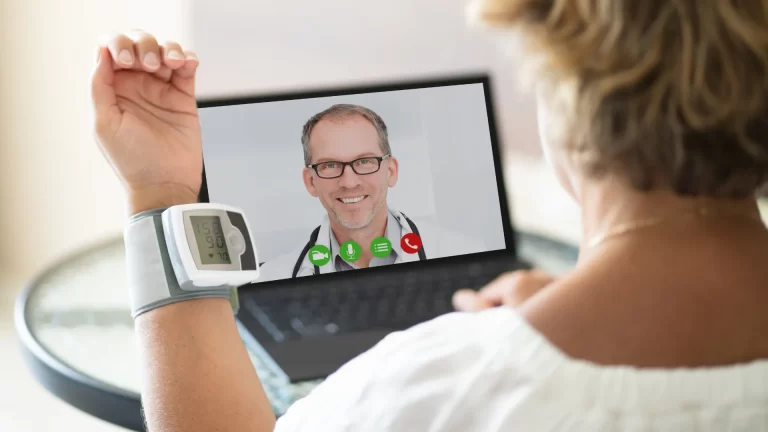Key Points:
- Virtual therapy has expanded access for rural, mobility-limited, and otherwise underserved populations.
- Studies show that teletherapy is as effective as in-person sessions for managing anxious thoughts and depressive states.
- Users report strong satisfaction with online platforms, often citing convenience, perceived privacy, and emotional comfort.
- Therapists are embracing virtual tools and adapting their methods to meet users where they are.
- Policy shifts post-pandemic have permanently broadened telehealth access for many.
The Rise of Virtual Therapy: A Shift That’s Here to Stay
What began as a pandemic response has evolved into an enduring, widely used option for mental health care – though the share of visits varies by setting and over time. Today, more people than ever are receiving therapy through secure video calls, audio sessions, and app-based messaging – often with outcomes that match, or even exceed, traditional in-office care.
As of 2024, teletherapy accounts for about one-third of all outpatient mental health visits in the U.S. The shift is about more than just convenience – it’s enabling care that is more consistent, more accessible, and in many cases, more aligned with the realities of modern life.
Why It Matters: A Crisis of Access and Stigma
About one in five U.S. adults experiences a mental illness annually; many people with diagnosable symptoms still do not receive therapy. The barriers are often logistical – transportation challenges, inflexible schedules, or a shortage of local providers – but they’re also emotional. Many people avoid seeking therapy due to stigma, privacy concerns, or cultural pressures.
Telehealth helps address both. It allows users to access care from a safe and familiar environment, often making it easier to open up and stick with therapy over time.
What the Science Says: Outcomes That Hold Up
Multiple peer-reviewed studies now confirm what users have long suspected: teletherapy works.
A 2022 meta-analysis published in the Journal of Affective Disorders reviewed 17 randomised controlled studies and found that virtual therapy produced similar improvements in depressive states and anxious thoughts compared to in-person care. Other studies have shown that tele-CBT (Cognitive Behavioural Therapy) is particularly effective for managing trauma and stress-related symptoms, including among veterans and adolescents.
Even more intensive approaches like Dialectical Behaviour Therapy (DBT) and trauma-informed care are seeing promising results when delivered through secure platforms, especially when users can access interactive tools and communicate between sessions.
How Telehealth Removes Real-World Barriers
1. Reaching the Underserved
For users in rural or remote areas, the availability of mental health professionals is often scarce. According to the CDC, more than 115 million Americans live in areas with a shortage of mental health providers. Teletherapy is helping close that gap. In a 2023 federal survey, over 65% of rural mental health visits were conducted virtually, up from just 3% in 2019.
2. Reducing the Stigma
Telehealth also offers a layer of privacy that traditional therapy can’t always guarantee. In communities where mental health conversations remain taboo, logging in from home – away from watchful eyes – can feel safer and more dignified. This emotional buffer is particularly valuable for marginalised groups, including LGBTQ+ users and first-generation immigrants.
3. Fitting Into Daily Life
Virtual therapy allows people to attend sessions on lunch breaks, between shifts, or after bedtime routines. According to a 2023 report, flexibility and time savings are among the top reasons users prefer teletherapy – and those conveniences are directly tied to better therapy adherence and outcomes.
The Technology Making It All Work
Platforms like BetterHelp, Talkspace, Amwell, and Teladoc offer HIPAA-compliant video sessions, secure chat features, and app-based scheduling. Some services use AI-powered matching algorithms to pair users with therapists based on speciality, experience, and cultural fit.
These tools are not just bells and whistles – they enhance access and improve user engagement. Features like asynchronous messaging (sending notes or check-ins between sessions) are increasingly common and have been shown to boost continuity of care, especially for those managing chronic symptoms.
Therapists are receiving specialised training in virtual rapport-building, safety protocols, and adapting evidence-based techniques for online settings. As the American Psychological Association notes, the core of therapy remains the same: a trusted relationship and collaborative process – even if it starts with a screen.
What Users and Therapists Are Saying
User satisfaction rates for teletherapy are consistently high. In a 2023 APA survey, 84% of respondents said they were satisfied with their virtual therapy experience, and many reported that being in their own space helped them feel more comfortable and open.
For therapists, the shift has required flexibility – but it’s also revealed unexpected benefits. “Seeing users in their own environments helps me understand their world better,” said a clinical psychologist interviewed in a Lancet Psychiatry interview. “It brings context you don’t get in an office.”
Costs, Coverage, and Policy Progress
Affordability remains a concern – but there’s good news. As of 2024:
- Most major insurers – including Medicare and Medicaid – cover teletherapy services.
- Some subscription platforms advertise lower per-session costs, but the total out-of-pocket expense depends on insurance coverage and platform pricing.
- Pandemic-era policies that expanded telehealth access have been made permanent in several states, including provisions for cross-state licensure and payment parity.
However, gaps still exist. Not everyone has access to high-speed internet, and non-English-language services remain limited on many platforms.
A Look Beyond the U.S.
Globally, teletherapy is playing a critical role in humanitarian and low-resource settings. In Ukraine, for example, mobile mental health services have helped over 30,000 people cope with trauma amid the ongoing war. In Kenya, youth-focused text counselling programs are providing care for adolescents facing emotional and social pressure, especially in underserved schools.
The World Health Organization sees digital mental health as a core strategy for global health equity, particularly in crisis response and community care efforts.
Bottom Line: Digital, Yes – But Deeply Human
Teletherapy is not a watered-down version of in-person care – it’s a reimagined, modern approach that meets users where they are, both physically and emotionally.
The tools may be digital, but the outcomes – emotional stability, self-awareness, and human connection – are deeply real.
What to Do Next
- Looking for a therapist? Start with directories like Psychology Today, or explore platforms like BetterHelp, Talkspace, or Amwell.
- Need affordable options? Visit Mental Health America or explore coverage through Medicaid or your employer.
- Want to stay informed on policy? Track updates via Telehealth.HHS.gov or your state health department.
This blog post aims to be informational and should not replace professional health advice. Always consult with a health professional for personalised advice.
Subscribe for Free for more insightful health articles tailored to your needs.
Sources
- NIMH (2023). “Mental Illness Statistics.” https://www.nimh.nih.gov/health/statistics/mental-illness
- Giovanetti. et al. (2022). “Teletherapy Versus In-Person Psychotherapy for Depression: A Meta-Analysis of Randomized Controlled Trials.” https://pubmed.ncbi.nlm.nih.gov/35007437/
- Morland, L.A. et al. (2020). “Advances in PTSD Treatment Delivery: Review of Findings and Clinical Considerations for the Use of Telehealth Interventions for PTSD.” https://pmc.ncbi.nlm.nih.gov/articles/PMC7261035/
- CDC (2023). “Mental Health Provider Shortage Data.” https://www.cdc.gov
- ASPE (2023). “Telehealth in Rural Areas.” https://aspe.hhs.gov
- APA (2022). “Mental Health and Equity Report.” https://www.apa.org
- APA Services (2023). “Telepsychology Best Practices.” https://www.apaservices.org
- CMS (2024). “Medicare Telehealth Services.” https://www.cms.gov
- HHS (2024). “Telehealth Policy Updates.” https://telehealth.hhs.gov
- WHO (2023). “Ukraine Crisis Mental Health Response.” https://www.who.int





Telehealth therapy sounds so helpful and easy
Therapy from home feels safe and effective—great read
Nice to see online mental‑health care working so well.